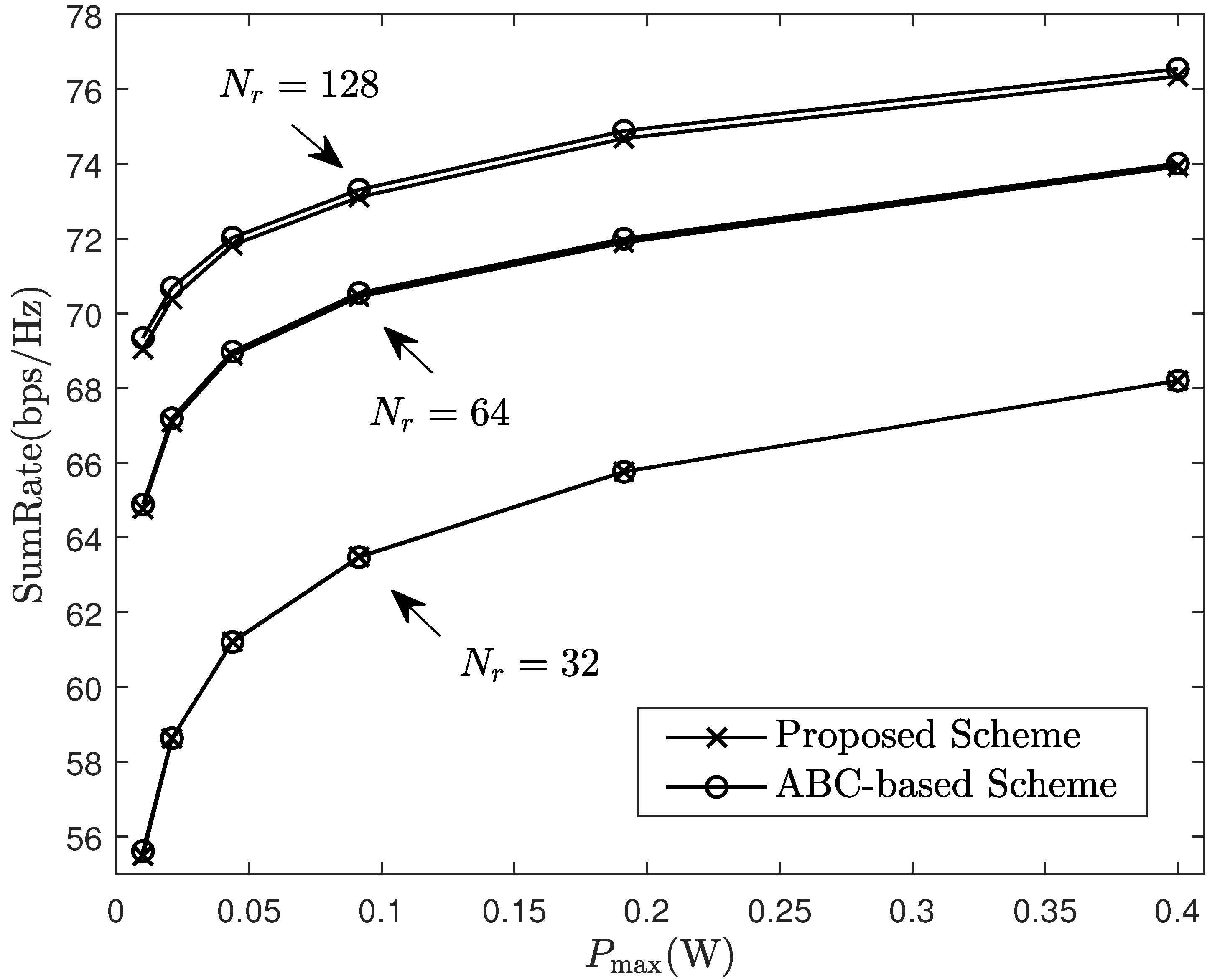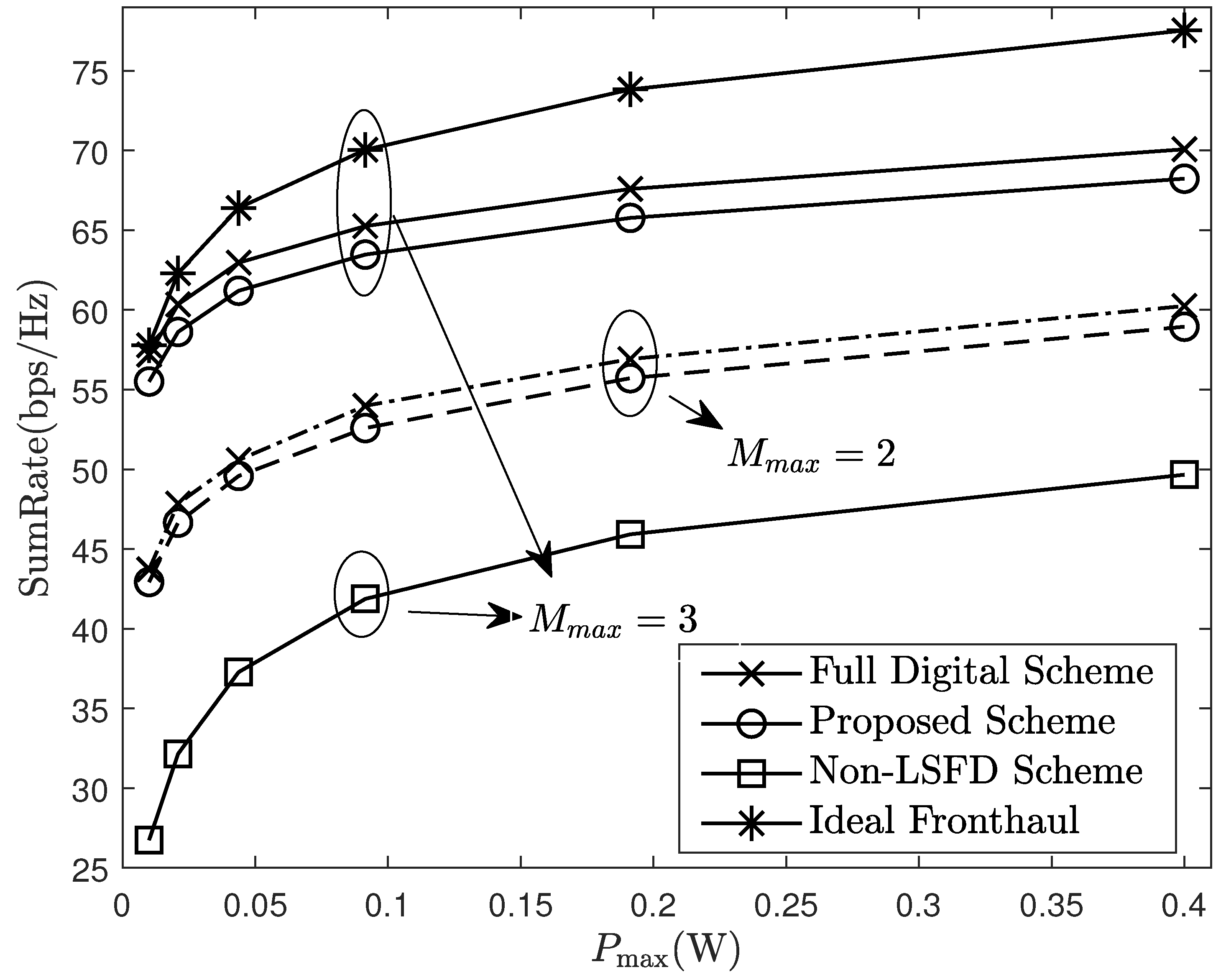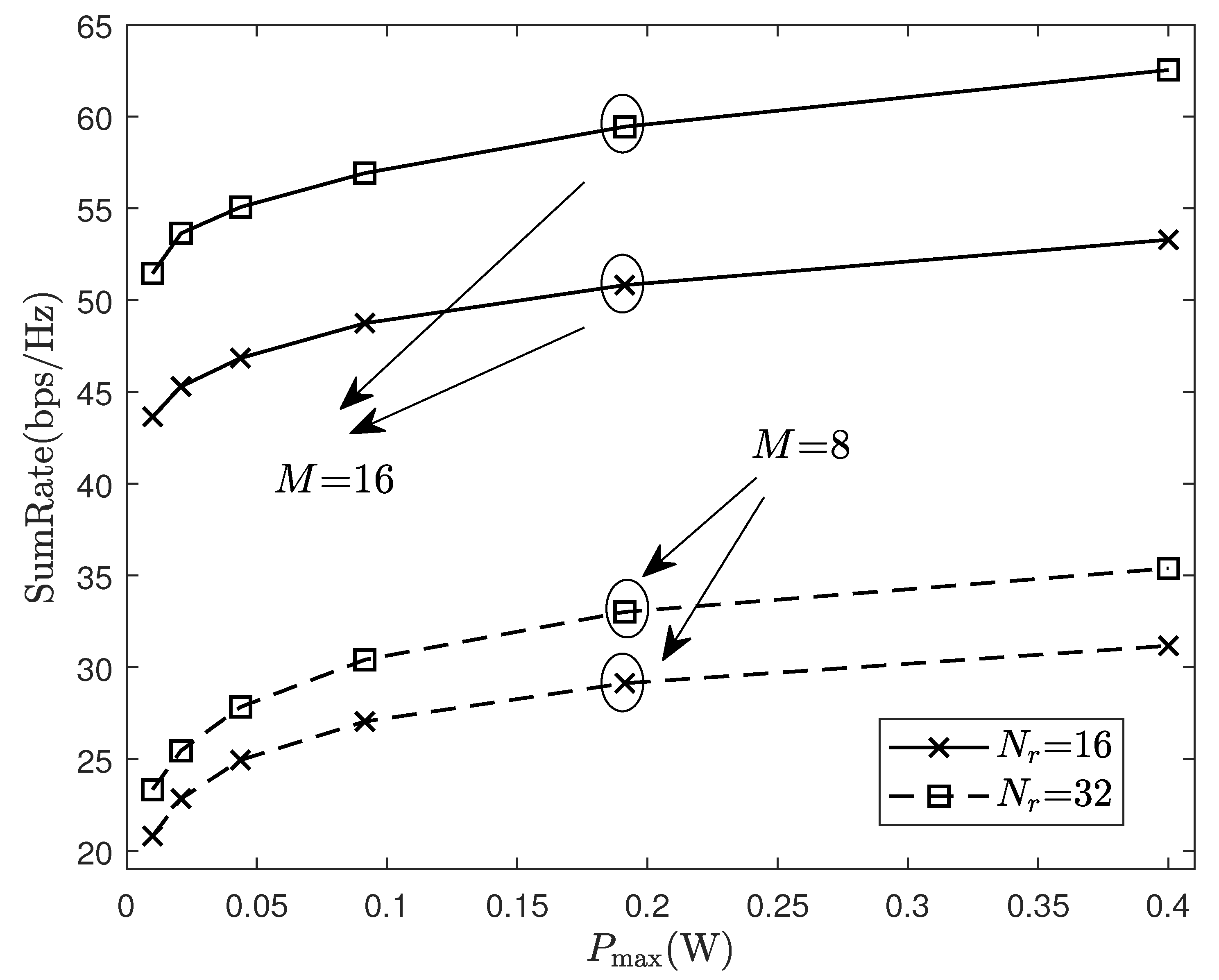Joint Power Allocation and Hybrid Beamforming for Cell-Free mmWave Multiple-Input Multiple-Output with Statistical Channel State Information
Abstract
:1. Introduction
1.1. Related Works and Motivation
1.2. Main Contributions
- Decentralized Cell-Free mmWave MIMO Architecture: We focus on a decentralized cell-free mmWave MIMO architecture where a HBF structure is deployed at each AP. The received signals are processed locally before being sent to the CPU. The CPU performs the weighting combination using the LSFD method, which is applied here for the first time in cell-free mmWave MIMO systems.
- Novel AP–User Association Strategy: We introduce a novel AP–user association strategy that leverages channel covariance. After pairing users with APs, we formulate a sum-rate maximization problem based on statistical CSI, subject to constraints on fronthaul capacity and minimum rate.
- Efficient Resource Allocation Scheme: We present an efficient resource allocation scheme designed to address the problem of multiple variable coupling. The experimental results show that the proposed strategy achieves a sum-rate comparable to that of benchmark schemes and that employing the LSFD method at the CPU significantly enhances the system performance.
2. System Model
2.1. Channel Model
2.2. Uplink Data Transmission
| Algorithm 1 AP-user association algorithm |
|
2.3. Optimization Problem Formulation
3. HBF Design and Power Allocation
3.1. Power Allocation Scheme
- (1)
- Optimize for fixed .
- (2)
- Optimize for fixed .
- (3)
- Optimize for fixed .
3.2. Hybrid Beamforming Design
- (1)
- Optimize for fixed .
- (2)
- Optimize for fixed .
| Algorithm 2 Power Allocation Algorithm for |
|
| Algorithm 3 HBF Design Algorithm for |
4. Simulation Results
4.1. Convergence Behaviour
4.2. Performance Evaluation
5. Conclusions
Author Contributions
Funding
Institutional Review Board Statement
Informed Consent Statement
Data Availability Statement
Conflicts of Interest
References
- Lin, Z.; Lin, M.; Cola, T.; Wang, J.-B.; Zhu, W.-P.; Cheng, J. Supporting IoT with rate-splitting multiple access in satellite and aerial-integrated networks. IEEE Internet Things J. 2021, 8, 11123–11134. [Google Scholar] [CrossRef]
- Lin, Z.; An, K.; Niu, H.; Hu, Y.; Chatzinotas, S.; Zheng, G.; Wang, J. SLNR-based secure energy efficient beamforming in multibeam satellite systems. IEEE Trans. Aerosp. Electron. Syst. 2023, 59, 2085–2088. [Google Scholar] [CrossRef]
- Wang, R.; Shen, M.; He, Y.; Liu, X. Joint AP-user association and caching strategyfor delivery delay minimization in cell-free massiveMIMO systems. IET Commun. 2024, 18, 96–109. [Google Scholar] [CrossRef]
- Ayidh, A.; Alammar, M.M. Energy efficient RF chains selection based onintegrated Hungarian and genetic approaches for uplinkcell-free millimetre-wave massive MIMO systems. IET Commun. 2024, 18, 569–582. [Google Scholar] [CrossRef]
- Nguyen, L.D.; Duong, T.Q.; Ngo, H.Q.; Tourki, K. Energy Efficiency in Cell-Free Massive MIMO with Zero-Forcing Precoding Design. IEEE Commun. Lett. 2017, 21, 1871–1874. [Google Scholar] [CrossRef]
- Doan, T.X.; Ngo, H.Q.; Duong, T.Q.; Tourki, K. On the Performance of Multigroup Multicast Cell-Free Massive MIMO. IEEE Commun. Lett. 2017, 21, 2642–2645. [Google Scholar] [CrossRef]
- Maryopi, D.; Bashar, M.; Burr, A. On the Uplink Throughput of Zero Forcing in Cell-Free Massive MIMO with Coarse Quantization. IEEE Trans. Veh. Technol. 2019, 68, 7220–7224. [Google Scholar] [CrossRef]
- Bashar, M.; Cumanan, K.; Burr, A.G.; Ngo, H.Q.; Debbah, M.; Xiao, P. Max–Min Rate of Cell-Free Massive MIMO Uplink with Optimal Uniform Quantization. IEEE Trans. Commun. 2019, 67, 6796–6815. [Google Scholar] [CrossRef]
- Bashar, M.; Cumanan, K.; Burr, A.G.; Ngo, H.Q.; Larsson, E.G.; Xiao, P. Energy Efficiency of the Cell-Free Massive MIMO Uplink with Optimal Uniform Quantization. IEEE Trans. Green Commun. Netw. 2019, 3, 971–987. [Google Scholar] [CrossRef]
- Nguyen, T.K.; Nguyen, H.H.; Tuan, H.D. Max-Min QoS Power Control in Generalized Cell-Free Massive MIMO-NOMA with Optimal Backhaul Combining. IEEE Trans. Veh. Technol. 2020, 69, 10949–10964. [Google Scholar] [CrossRef]
- Ezekiel, A.E.; Okafor, K.C.; Tersoo, S.T.; Alabi, C.A.; Abdulsalam, J.; Imoize, A.L.; Jogunola, O.; Anoh, K. Enhanced Energy Transfer Efficiency for IoT-Enabled Cyber-Physical Systems in 6G Edge Networks with WPT-MIMO-NOMA. Technologies 2024, 12, 119. [Google Scholar] [CrossRef]
- Park, S.; Park, J.; Yazdan, A.; Heath, R.W. Exploiting Spatial Channel Covariance for Hybrid Precoding in Massive MIMO Systems. IEEE Trans. Signal Process. 2017, 65, 3818–3832. [Google Scholar] [CrossRef]
- Lin, Z.; Lin, M.; Champagne, B.; Zhu, W.-P.; Al-Dhahir, N. Secrecy-energy efficient hybrid beamforming for satellite-terrestrial integrated networks. IEEE Trans. Commun. 2021, 69, 6345–6360. [Google Scholar] [CrossRef]
- Lin, Z.; Niu, H.; He, Y.; An, K.; Zhong, X.; Chu, Z.; Xiao, P. Self-powered absorptive reconfigurable intelligent surfaces for securing satellite-terrestrial integrated networks. China Commun. 2024, 21, 276–291. [Google Scholar]
- Rappaport, T.S.; Sun, S.; Mayzus, R.; Zhao, H.; Azar, Y.; Wang, K.; Gutierrez, F.; Schulz, J.K.; Samimi, M.K.; Wong, G.N. Millimeter Wave Mobile Communications for 5G Cellular: It Will Work! IEEE Access 2013, 1, 335–349. [Google Scholar] [CrossRef]
- Roh, W.; Seol, J.Y.; Park, J.; Lee, B.; Lee, J.; Kim, Y.; Aryanfar, F.; Cheun, K.; Cho, J. Millimeter-wave beamforming as an enabling technology for 5G cellular communications: Theoretical feasibility and prototype results. IEEE Commun. Mag. 2014, 52, 106–113. [Google Scholar] [CrossRef]
- Lin, C.; Li, G.Y. Energy-Efficient Design of Indoor mmWave and Sub-THz Systems with Antenna Arrays. IEEE Trans. Wirel. Commun. 2016, 15, 4660–4672. [Google Scholar] [CrossRef]
- Feng, C.; Shen, W.; An, J.; Hanzo, L. Weighted sum rate maximization of the mmWave cell-free MIMO downlink relying on hybrid precoding. IEEE Trans. Wireless Commun. 2022, 21, 2547–2560. [Google Scholar] [CrossRef]
- Nguyen, N.T.; Lee, K.; Dai, H. Hybrid beamforming and adaptive RF chain activation for uplink cell-free millimeter-wave massive MIMO systems. IEEE Trans. Veh. Technol. 2022, 71, 8739–8755. [Google Scholar] [CrossRef]
- Wang, Z.; Li, M.; Liu, R.; Liu, Q. Joint user association and hybrid beamforming designs for cell-free mmWave MIMO communications. IEEE Trans. Commun. 2022, 70, 7307–7321. [Google Scholar] [CrossRef]
- Femenias, G.; Riera-Palou, F. Cell-free millimeter-wave massive MIMO systems with limited fronthaul capacity. IEEE Access 2019, 7, 44596–44612. [Google Scholar] [CrossRef]
- Kim, I.-S.; Bennis, M.; Choi, J. Cell-free mmWave massive MIMO systems with low-capacity fronthaul links and low-resolution ADC/DACs. IEEE Trans. Veh. Technol. 2022, 71, 10512–10526. [Google Scholar] [CrossRef]
- He, Y.; Shen, M.; Zeng, F.; Zheng, H.; Wang, R.; Zhang, M.; Liu, X. Energy efficient power allocation for cell-free mmWave massive MIMO with hybrid precoder. IEEE Commun. Lett. 2022, 26, 394–398. [Google Scholar] [CrossRef]
- Demirhan, U.; Alkhateeb, A. Enabling Cell-Free Massive MIMO Systems with Wireless Millimeter Wave Fronthaul. IEEE Trans. Wirel. Commun. 2022, 21, 9482–9496. [Google Scholar] [CrossRef]
- Jafri, M.; Srivastava, S.; Venkategowda, N.K.D.; Jagannatham, A.K.; Hanzo, L. Cooperative Hybrid Transmit Beamforming in Cell-Free mmWave MIMO Networks. IEEE Trans. Veh. Technol. 2023, 72, 6023–6038. [Google Scholar] [CrossRef]
- Lee, J.; Gil, G.-T.; Lee, Y.H. Channel Estimation via Orthogonal Matching Pursuit for Hybrid MIMO Systems in Millimeter Wave Communications. IEEE Trans. Commun. 2016, 64, 2370–2386. [Google Scholar] [CrossRef]
- Zhao, L.; Ng, D.W.K.; Yuan, J. Multi-User Precoding and Channel Estimation for Hybrid Millimeter Wave Systems. IEEE J. Sel. Areas Commun. 2017, 35, 1576–1590. [Google Scholar] [CrossRef]
- Zhao, D.; Lu, H.; Wang, Y.; Sun, H.; Gui, Y. Joint Power Allocation and User Association Optimization for IRS-Assisted mmWave Systems. IEEE Trans. Wirel. Commun. 2022, 21, 577–590. [Google Scholar] [CrossRef]
- Van Chien, T.; Björnson, E.; Larsson, E.G. Joint Power Allocation and User Association Optimization for Massive MIMO Systems. IEEE Trans. Wirel. Commun. 2016, 15, 6384–6399. [Google Scholar] [CrossRef]
- Spantideas, S.T.; Giannopoulos, A.E.; Kapsalis, N.C.; Kalafatelis, A.; Capsalis, C.N.; Trakadas, P. Joint Energy-efficient and Throughput-sufficient Transmissions in 5G Cells with Deep Q-Learning. In Proceedings of the 2021 IEEE International Mediterranean Conference on Communications and Networking (MeditCom), Athens, Greece, 7–10 September 2021; pp. 265–270. [Google Scholar]
- Dai, C.; Zhu, K.; Hossain, E. Multi-Agent Deep Reinforcement Learning for Joint Decoupled User Association and Trajectory Design in Full-Duplex Multi-UAV Networks. IEEE Trans. Mob. Comput. 2023, 22, 6056–6070. [Google Scholar] [CrossRef]
- Buzzi, S.; D’Andrea, C. On clustered statistical MIMO millimeter wave channel simulation. CoRR arXiv 2016, arXiv:1604.00648. [Google Scholar]
- Guo, J.-C.; Yu, Q.-Y.; Sun, W.-B.; Meng, W.-X. Robust efficient hybrid pre-coding scheme for mmWave cell-free and user-centric massive MIMO communications. IEEE Trans. Wireless Commun. 2021, 20, 8006–8022. [Google Scholar] [CrossRef]
- Zheng, J.; Zhang, J.; Björnson, E.; Li, Z.; Ai, B. Cell-Free Massive MIMO-OFDM for High-Speed Train Communications. IEEE J. Sel. Areas Commun. 2022, 40, 2823–2839. [Google Scholar] [CrossRef]
- Zhou, Y.; Yu, W. Fronthaul compression and transmit beamforming optimization for multi-antenna uplink C-RAN. IEEE Trans. Signal Process. 2016, 64, 4138–4151. [Google Scholar] [CrossRef]
- Masoumi, H.; Emadi, M.J. Performance Analysis of Cell-Free Massive MIMO System with Limited Fronthaul Capacity and Hardware Impairments. IEEE Trans. Wirel. Commun. 2020, 19, 1038–1053. [Google Scholar] [CrossRef]
- Björnson, E.; Sanguinetti, L. Making cell-free massive MIMO competitive with MMSE processing and centralized implementation. IEEE Trans. Wireless Commun. 2020, 19, 77–90. [Google Scholar] [CrossRef]
- Zhang, Q.; Jin, S.; Wong, K.-K.; Zhu, H.; Matthaiou, M. Power scaling of uplink massive MIMO systems with arbitrary-rank channel means. IEEE J. Sel. Top. Signal Process. 2014, 8, 966–981. [Google Scholar] [CrossRef]
- Shen, K.; Yu, W. Fractional programming for communication systems—part I: Power control and beamforming. IEEE Trans. Signal Process. 2018, 66, 2616–2630. [Google Scholar] [CrossRef]
- Papandriopoulos, J.; Evans, J.S. SCALE: A Low-Complexity Distributed Protocol for Spectrum Balancing in Multiuser DSL Networks. IEEE Trans. Inf. Theory 2009, 55, 3711–3724. [Google Scholar] [CrossRef]
- Yuille, A.L.; Rangarajan, A. The Concave-Convex Procedure. Neural Comput. 2003, 15, 915–936. [Google Scholar] [CrossRef] [PubMed]
- Shen, K.; Yu, W. Fractional programming for communication systems—Part II: Uplink scheduling via matching. IEEE Trans. Signal Process. 2018, 66, 2631–2644. [Google Scholar] [CrossRef]
- Lin, Z.; Niu, H.; An, K.; Wang, Y.; Zheng, G.; Chatzinotas, S.; Hu, Y. Refracting RIS aided hybrid satellite-terrestrial relay networks: Joint beamforming design and optimization. IEEE Trans. Aerosp. Electron. Syst. 2022, 58, 3717–3724. [Google Scholar] [CrossRef]
- Sun, Y.; Babu, P.; Palomar, D.P. Majorization-minimization algorithms in signal processing, communications, and machine learning. IEEE Trans. Signal Process. 2017, 65, 794–816. [Google Scholar] [CrossRef]
- Grant, M.; Boyd, S. CVX: MATLAB Software for Disciplined Convex Programming. Version 2.1. 2017. Available online: http://cvxr.com/cvx (accessed on 10 August 2024).
- Alonzo, M.; Buzzi, S.; Zappone, A.; D’Elia, C. Energy-Efficient Power Control in Cell-Free and User-Centric Massive MIMO at Millimeter Wave. IEEE Trans. Green Commun. Netw. 2019, 3, 651–663. [Google Scholar] [CrossRef]
- Kim, S.; Shim, B. Energy-Efficient Millimeter-Wave Cell-Free Systems Under Limited Feedback. IEEE Trans. Commun. 2021, 69, 4067–4082. [Google Scholar] [CrossRef]
- Wang, J.; Wang, B.; Fang, J.; Li, H. Millimeter Wave Cell-Free Massive MIMO Systems: Joint Beamforming and AP-User Association. IEEE Wirel. Commun. Lett. 2022, 11, 298–302. [Google Scholar] [CrossRef]
- Chen, P.; Li, H.; Ma, L. Distributed massive UAV jamming optimizationalgorithm with artificial bee colony. IET Commun. 2023, 17, 197–206. [Google Scholar] [CrossRef]








| Parameter | Value |
|---|---|
| Noise power: | [20] |
| Number of antennas: | 32 [33,47] |
| Number of RF links: | 8 |
| Number of users: K | 6 |
| Carrier frequency: | [32] |
| Number of APs: M | 16 |
| Maximum transmit power: | |
| Minimum rate: | |
| Maximum fronthaul capacity: | [21,22] |
| Number of APs serving each user: | 3 |
| Side of the coverage area: D | 400 m [46,48] |
Disclaimer/Publisher’s Note: The statements, opinions and data contained in all publications are solely those of the individual author(s) and contributor(s) and not of MDPI and/or the editor(s). MDPI and/or the editor(s) disclaim responsibility for any injury to people or property resulting from any ideas, methods, instructions or products referred to in the content. |
© 2024 by the authors. Licensee MDPI, Basel, Switzerland. This article is an open access article distributed under the terms and conditions of the Creative Commons Attribution (CC BY) license (https://creativecommons.org/licenses/by/4.0/).
Share and Cite
Bai, J.; Wang, G.; Wang, M.; Zhu, J. Joint Power Allocation and Hybrid Beamforming for Cell-Free mmWave Multiple-Input Multiple-Output with Statistical Channel State Information. Sensors 2024, 24, 6276. https://doi.org/10.3390/s24196276
Bai J, Wang G, Wang M, Zhu J. Joint Power Allocation and Hybrid Beamforming for Cell-Free mmWave Multiple-Input Multiple-Output with Statistical Channel State Information. Sensors. 2024; 24(19):6276. https://doi.org/10.3390/s24196276
Chicago/Turabian StyleBai, Jiawei, Guangying Wang, Ming Wang, and Jinjin Zhu. 2024. "Joint Power Allocation and Hybrid Beamforming for Cell-Free mmWave Multiple-Input Multiple-Output with Statistical Channel State Information" Sensors 24, no. 19: 6276. https://doi.org/10.3390/s24196276






